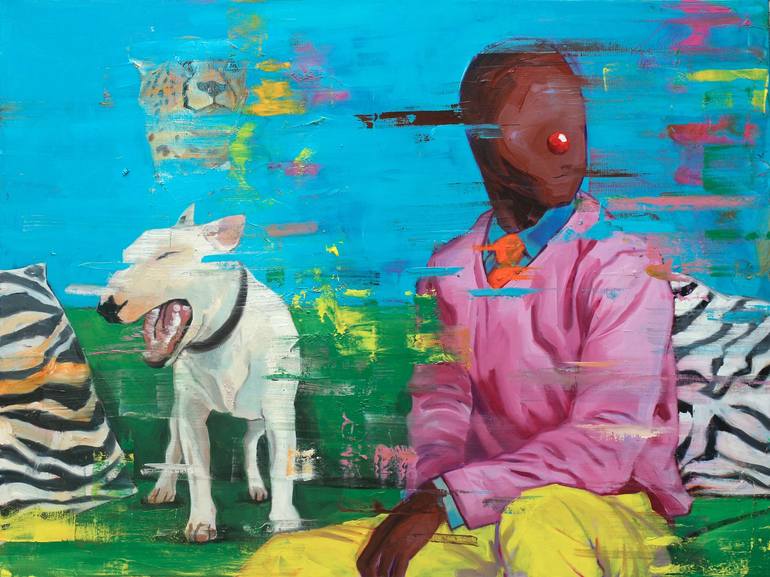





VIEW IN MY ROOM
Where Is My Noah? Painting
Hong Kong
Painting, Oil on Canvas
Size: 47.2 W x 35.4 H x 0.8 D in
Ships in a Crate
Shipping included
14-day satisfaction guarantee
Artist Recognition

NFT Artist

Featured in the Catalog

Artist featured in a collection
About The Artwork
Announcements that Elon Musk's Neuralink company is developing a brain-computer interface inspired my seventh collection. Neuralink’s plan is to access the human brain via a tiny hole. This small hole would allow a small chip and its associated wiring to be implanted into the brain. The chip will get power from and communicate with wireless hardware located behind the ear, much like a cochlear implant. Despite claims of the positive effect on humanity that such technology could bring, my response was: “This has to be a joke!” (especially since Musk had previously warned against the threat of artificial intelligence). To me, the idea of a brain implant that would allow us to connect directly to the internet at all times is a joke on humanity – and this is the theme that I explore in my collection. In “Glitches of the Future”, I envision an unsettling future in which humans lose their humanity as they “merge” with artificial intelligence. I portrayed tech-enabled humans as “jokers”, ridiculous in their need to be online 24/7. With information fed straight to their brains, it made me think perhaps they do not need eyes or ears, or a mouth even – in fact, they could be people without any senses. Paintings in the series ask of the viewer: How would such humans function in their relationships with other people, nature and pets in the future? Depicted living in a colourful world but connected permanently to the internet, to show how disconnected they are from their surroundings and those around them, I used “glitchy” effects to show them fading away from other people, or disconnecting from nature. Whether they are with their partner, their pet or alone, I want to show how their attention is directed within. Having surrendered their feelings and faculties to A.I, with the potential to malfunction like a computer, the images suggest that they are the glitches of the future.
Details & Dimensions
Painting:Oil on Canvas
Original:One-of-a-kind Artwork
Size:47.2 W x 35.4 H x 0.8 D in
Frame:Not Framed
Ready to Hang:Not applicable
Packaging:Ships in a Crate
Shipping & Returns
Delivery Time:Typically 5-7 business days for domestic shipments, 10-14 business days for international shipments.
Handling:Ships in a wooden crate for additional protection of heavy or oversized artworks. Crated works are subject to an $80 care and handling fee. Artists are responsible for packaging and adhering to Saatchi Art’s packaging guidelines.
Ships From:Hong Kong.
Have additional questions?
Please visit our help section or contact us.
Hong Kong
Kos Cos is an abstract artist from Sri Lanka residing in Hong Kong. He is known for his unconventional approach to art, which involves using bold brushstrokes, vivid colours, and movement. By employing innovative techniques of form, geometry, and pattern, Kos Cos explores the nature of human thoughts and the cyclical aspect of life. His art is influenced by the aesthetics of billboard paintings that were prevalent in Sri Lanka during the 1990s, as well as advertising. Kos Cos also received training in cartoon drawing under the tutelage of Sri Lankan cartoonist Mr S. C. Opatha. Kos Cos has exhibited his artwork in both the United Kingdom and Hong Kong. He was a finalist for the 2018 Royal Art Prize and was also chosen as one of the artists for Saatchi Art's inaugural NFT drop, 'The Other Avatars,' in 2022. His art has been acquired by prestigious institutions such as Standard Chartered Bank, HSBC Hong Kong, and the Hong Kong Museum of Medical Sciences, in addition to private collectors from the United States, United Kingdom, France, Belgium, China, Hong Kong, Japan, and Australia.
Artist Recognition

Featured in Saatchi Art's printed catalog, sent to thousands of art collectors

Artist featured by Saatchi Art in a collection
Thousands Of Five-Star Reviews
We deliver world-class customer service to all of our art buyers.
Global Selection
Explore an unparalleled artwork selection by artists from around the world.
Satisfaction Guaranteed
Our 14-day satisfaction guarantee allows you to buy with confidence.
Support An Artist With Every Purchase
We pay our artists more on every sale than other galleries.
Need More Help?